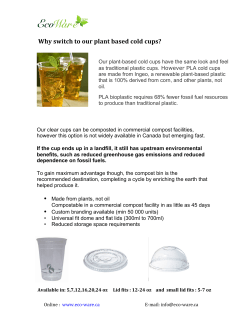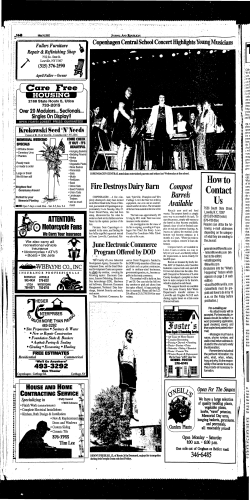
Tips for Healthier - NC Composting Council
How much compost to use when planting? Trees and Shrubs – Backfill plantings with a 50:50 mix of compost and native soil. Mulch a 2 to 3 inch layer of compost around plants extending 6 inches beyond the drip line. Do not mound compost or mulch around stems and tree trunks because this invites insects and diseases. Flowers and Vegetable Gardens – Work 2 to 3 inches of compost into the top 6 inches of soil before planting. Turf Grass – Work 2 to 3 inches of compost into the top 6 inches of soil prior to sod placement or seeding. Containers and Raised Beds – Add transplants to containers and beds filled with a 30 percent blend of compost and potting soil. Foundations – Replace compacted and contaminated fill along building foundations with a blend of compost, sand and topsoil. Mulch – Spread a 2 to 3 inch layer around plants to prevent erosion, act as a weed barrier and conserve water. NC Composting Council, Inc. PO Box 24961 | Raleigh, NC 27611 Phone: 919-612-9975 www.carolinacompost.com Mix Calculator: Creating a landscape bed? Use this formula: square feet to be covered X depth to be filled (in inches) X 0.0031 = cubic yards of mix needed. Depth of Compost Layer Cubic Yards Needed Per 1,000 Square Feet 1/2 inch layer 1 inch layer 1 1/2 inch layer 2 inches layer 3 inches layer 1.5 cubic yards 3.0 cubic yards 4.5 cubic yards 6.0 cubic yards 9.0 cubic yards Member Sticker All rights reserved | NC Composting Council, Inc. 10 Tips for Healthier Soil & Plants 10 Tips for Healthier Soil & Plants 1. It’s alive! It’s alive! Like every other living 6. It looks like soil. Look for compost that organism, soil needs food, water and oxygen. Feed your soil to grow healthier plants. Keep it aerated. Don’t let it dry out or become water logged. is dark in color and smells like soil. Immature compost may burn sensitive plants and compete for nutrients. 2. Break it up. Soil preparation is an important first step. Don’t skip it. Break up large areas of high compaction by tilling and amending with compost before planting. Dig planting beds to a depth of 6 to 12 inches and add compost. 3. Boost resistance. Compost is microbiologically active like yogurt and yeast. This helps plants with nutrient uptake as well as builds resistance to pests and diseases. Do not use fumigants and harsh chemicals that will kill hard-working microbes and cancel one of compost’s most desirable benefits. For more information visit our new website at www.carolinacompost.com 4. Control run-off. Compost is one of the best products you can use to encourage rainwater to stay on your property. It will reduce erosion and minimize run-off of soils and nutrients to rivers and streams. Sediment and excess nutrients negatively impact water quality and aquatic life. 5. Waterhogs unite! Consider water resources when placing plants in the landscape. Plants that need more water should be located where water naturally collects – near downspouts, roof drip lines and similar locations. Use compost to improve both moisture retention and drainage. 7. A little bit does a lot. As little as 1/4 inch of compost as a top dressing can give lawns a boost. Bare spot? Add a layer of compost and rake into the soil before seeding. 8. Quality counts. The U.S. Composting Council has developed a marketing label to identify tested compost. Look for the Seal of Testing Assurance when comparing products. 9. Don’t concentrate! Add no more than 30 percent compost in a blend with bark, topsoil, sand, clay and other ingredients. Use in raised beds or in potting and planting mixes for trees, shrubs and garden plants. Used as a mulch, apply 2 to 3 inches to the surface. 10. Dress it up. Top dress with 1/4 to 1/2 inch of compost to replenish nutrients and keep root zones cool and moist. Surface applications should always be well incorporated with a rake or tilling equipment.
© Copyright 2026












